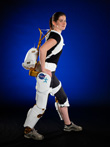
Project Engineer Shelley Rea demonstrates the X1 Robotic Exoskeleton. Image courtesy of Robert Markowitz.
The National Aeronautics and Space Administration (NASA) and the Florida Institute for Human & Machine Cognition (IHMC), Pensacola, with the help of engineers from Oceaneering Space Systems, Houston, Texas, have developed a robotic exoskeleton called X1, which may someday help astronauts stay healthier in space as well as assist individuals with paraplegia in walking.
A spinoff derived from NASA’s Robonaut 2 project, the 57-pound exoskeleton could be worn over a person’s body either to assist or inhibit movement in leg joints. In the inhibit mode, the robotic device would be used as an in-space exercise machine to supply resistance against leg movement. The same technology could be used in reverse on the ground, potentially helping some individuals with paraplegia to walk.
“What’s extraordinary about space technology and our work with projects like Robonaut are the unexpected possibilities space tech spinoffs may have right here on Earth,” said Michael Gazarik, PhD, director of NASA’s Space Technology Program. “It’s exciting to see a NASA-developed technology that might one day help people with serious ambulatory needs begin to walk again, or even walk for the first time.”
Worn over the legs with a harness that reaches up the back and around the shoulders, X1 has ten degrees of freedom, or joints-four motorized joints at the hips and the knees, and six passive joints that allow for sidestepping, turning, and pointing and flexing a foot. There also are multiple adjustment points, allowing the X1 to be used in many different ways.
X1 currently is in a research and development phase, where the primary focus is design, evaluation, and improvement of the technology. NASA is examining the potential for the X1 as an exercise device to improve crew health both aboard the space station and during future long-duration missions. In addition, the device has the ability to measure, record, and stream back, in real-time, data to flight controllers on Earth, giving physicians better feedback on the impact of the crew’s exercise regimen. As the technology matures, X1 also could provide a robotic power boost to astronauts as they work on the surface of distant planetary bodies.
IHMC is interested in developing and using X1 as an assistive walking device. By combining NASA technology and walking algorithms developed at IHMC, X1 has the potential to produce high torques to allow for assisted walking over varied terrain as well as stair climbing. Preliminary studies using X1 for this purpose have already started at IHMC.
The potential of X1 extends to other applications, including rehabilitation, gait modification, and offloading large amounts of weight from the wearer. Preliminary studies by IHMC have shown X1 to be more comfortable, easier to adjust, and easier to put on than previous exoskeleton devices. Researchers plan on improving on the X1 design, adding more active joints to areas such as the ankle and hip, which will, in turn, increase the potential uses for the device.




